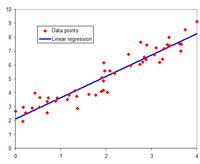
Photo from wikipedia
Obesity is associated with changes in the plasma lipids. Although simple lipid quantification is routinely used, plasma lipids are rarely investigated at the level of individual molecules. We aimed at… Click to show full abstract
Obesity is associated with changes in the plasma lipids. Although simple lipid quantification is routinely used, plasma lipids are rarely investigated at the level of individual molecules. We aimed at predicting different measures of obesity based on the plasma lipidome in a large population cohort using advanced machine learning modeling. A total of 1,061 participants of the FINRISK 2012 population cohort were randomly chosen, and the levels of 183 plasma lipid species were measured in a novel mass spectrometric shotgun approach. Multiple machine intelligence models were trained to predict obesity estimates, i.e., body mass index (BMI), waist circumference (WC), waist-hip ratio (WHR), and body fat percentage (BFP), and validated in 250 randomly chosen participants of the Malmö Diet and Cancer Cardiovascular Cohort (MDC-CC). Comparison of the different models revealed that the lipidome predicted BFP the best (R2 = 0.73), based on a Lasso model. In this model, the strongest positive and the strongest negative predictor were sphingomyelin molecules, which differ by only 1 double bond, implying the involvement of an unknown desaturase in obesity-related aberrations of lipid metabolism. Moreover, we used this regression to probe the clinically relevant information contained in the plasma lipidome and found that the plasma lipidome also contains information about body fat distribution, because WHR (R2 = 0.65) was predicted more accurately than BMI (R2 = 0.47). These modeling results required full resolution of the lipidome to lipid species level, and the predicting set of biomarkers had to be sufficiently large. The power of the lipidomics association was demonstrated by the finding that the addition of routine clinical laboratory variables, e.g., high-density lipoprotein (HDL)- or low-density lipoprotein (LDL)- cholesterol did not improve the model further. Correlation analyses of the individual lipid species, controlled for age and separated by sex, underscores the multiparametric and lipid species-specific nature of the correlation with the BFP. Lipidomic measurements in combination with machine intelligence modeling contain rich information about body fat amount and distribution beyond traditional clinical assays.
Journal Title: PLoS Biology
Year Published: 2019
Link to full text (if available)
Share on Social Media: Sign Up to like & get
recommendations!